
State Fair is a 1933 American pre-Code comedy-drama film directed by Henry King and starring Janet Gaynor, Will Rogers, and Lew Ayres. The film tells the story of a farm family's multi-day visit to the Iowa State Fair, where the parents seek to win prizes in agricultural and cooking competitions, and their teenage daughter and son each find unexpected romance.
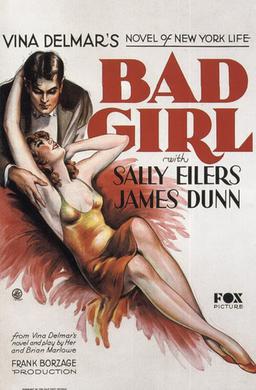
Bad Girl is a 1931 American pre-Code drama film directed by Frank Borzage and starring Sally Eilers, James Dunn, and Minna Gombell. The screenplay was adapted by Edwin J. Burke from the 1928 novel by Viña Delmar and the 1930 play by Delmar and Brian Marlowe. The plot follows the courtship and marriage of two young, working-class people and the misunderstandings that result from their not having learned to trust and communicate with one another. The film propelled then-unknown actors Eilers and Dunn to stardom. It was nominated for three Academy Awards, including Best Picture, and won for Best Director and Best Adapted Screenplay.

Grace Ethel Cecile Rosalie Allen was an American vaudevillian, singer, actress, and comedian who became internationally famous as the zany partner and comic foil of husband George Burns, her straight man, appearing with him on radio, television and film as the duo Burns and Allen.

Claire Trevor was an American actress. She appeared in 65 feature films from 1933 to 1982, winning the Academy Award for Best Supporting Actress for her role in Key Largo (1948), and received nominations for her roles in The High and the Mighty (1954) and Dead End (1937). Trevor received top billing, ahead of John Wayne, for Stagecoach (1939).
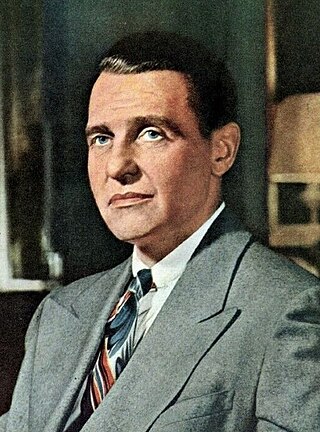
Ralph Rexford Bellamy was an American actor whose career spanned 65 years on stage, film, and television. During his career, he played leading roles as well as supporting roles, garnering acclaim and awards, including a Tony Award for Best Actor in a Play for Sunrise at Campobello as well as Academy Award for Best Supporting Actor nomination for The Awful Truth (1937).
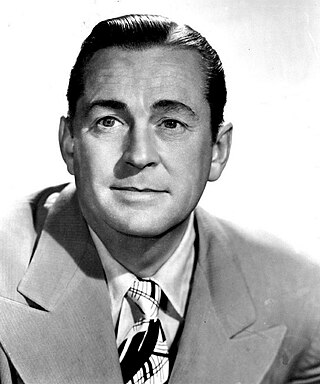
James Howard Dunn, billed as Jimmy Dunn in his early career, was an American actor and vaudeville performer. The son of a New York stockbroker, he initially worked in his father's firm but was more interested in theater. He landed jobs as an extra in short films produced by Paramount Pictures in its Long Island studio, and also performed with several stock theater companies, culminating with playing the male lead in the 1929 Broadway musical Sweet Adeline. This performance attracted the attention of film studio executives, and in 1931, Fox Film signed him to a Hollywood contract.

Bolero is a 1934 American pre-Code musical drama film directed by Wesley Ruggles and starring George Raft and Carole Lombard. The Paramount production was a rare chance for Raft to play a dancer, which had been his profession in New York City, rather than portraying a gangster. The film takes its title from the Maurice Ravel composition Boléro (1928). The supporting cast includes William Frawley, Ray Milland and Sally Rand.

Quick Millions is a 1931 pre-Code crime film directed by Rowland Brown and starring Spencer Tracy, Marguerite Churchill, Sally Eilers, and featuring George Raft as the sidekick with a solo eccentric dance performance.

Francis Charles Moran was an American boxer and film actor who fought twice for the Heavyweight Championship of the World, and appeared in over 135 movies in a 25-year film career.

Dorothea Sally Eilers was an American actress.
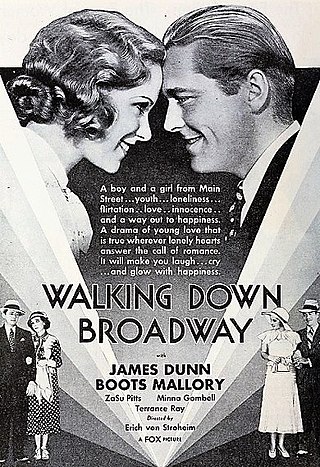
Hello, Sister! is a 1933 American pre-Code drama-romance film produced by Fox Film Corporation. It was directed by Erich von Stroheim, Raoul Walsh, Alfred L. Werker, and Edwin Burke, although none of those directors are credited. The film is a re-edited version of von Stroheim's now-lost film Walking Down Broadway.
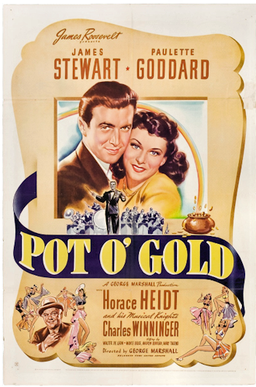
Pot o' Gold is a 1941 American romantic musical comedy film starring James Stewart and Paulette Goddard, directed by George Marshall, and based on the radio series Pot o' Gold. The film was released April 3, 1941, eight months before the NBC radio series came to an end. Paulette Goddard's singing voice was dubbed by Vera Van. The film was known as The Golden Hour in the United Kingdom.
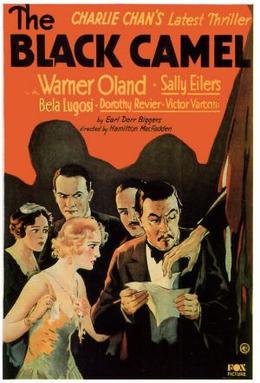
The Black Camel is a 1931 American pre-Code mystery film directed by Hamilton MacFadden and starring Warner Oland, Sally Eilers, Bela Lugosi, and Dorothy Revier. It is based on the 1929 novel of the same name by Earl Derr Biggers. It is the second film to star Oland as detective Charlie Chan, and the sole surviving title of the first five Chan films starring Oland. The Black Camel marked the film debut of Robert Young.
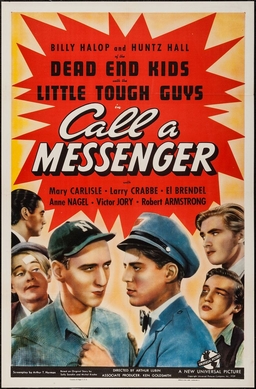
Call a Messenger is a 1939 Universal Studios film that starred Billy Halop and Huntz Hall of the Dead End Kids and several of the Little Tough Guys. It was directed by Arthur Lubin.
Marguerite Roberts was an American screenwriter, one of the highest paid in the 1930s. After she and her husband John Sanford refused to testify in 1951 before the House Un-American Activities Committee, she was blacklisted for nine years and unable to get work in Hollywood. She was hired again in 1962 by Columbia Pictures.

Women in the Wind is a 1939 film directed by John Farrow and starring Kay Francis, William Gargan and Victor Jory. The plot concerns women pilots competing in the so-called "Powder Puff Derby", an annual transcontinental air race solely for women.

Living on Love is a 1937 American romantic comedy film released by RKO Radio Pictures. Directed by Lew Landers, it stars James Dunn, Whitney Bourne, and Joan Woodbury. The film is a remake of the RKO film Rafter Romance (1933). It is one of the "lost RKO films" owned by Merian C. Cooper and only re-released in April 2007 when Turner Classic Movies acquired the rights and aired all six films on its channel.

Over the Hill is a 1931 American Pre-Code black-and-white melodrama film directed by Henry King for Fox Film Corporation. Starring Mae Marsh, James Dunn, Sally Eilers, and Olin Howland, the story concerns a young mother who devotedly cares for her children but when they grow up, most of them turn their backs on her and she has no choice but to go live in the poorhouse. The film is a remake of the 1920 silent film Over the Hill to the Poorhouse, which had been a major box-office hit for Fox. The story was based on a pair of poems by Will Carleton. Over the Hill also inspired the South Korean film adaptation Over the Ridge (1968). The production marked Marsh's first sound film and the second pairing of Dunn and Eilers, who had achieved celebrity in Fox's Bad Girl released earlier in the year.

Dance Team is a 1932 American Pre-Code comedy film directed by Sidney Lanfield and written by Edwin J. Burke. The film stars James Dunn, Sally Eilers, Ralph Morgan, Minna Gombell, Edward Crandall and Nora Lane. The film was released on January 17, 1932, by Fox Film Corporation.

Jimmy and Sally is a 1933 American pre-Code comedy-drama film directed by James Tinling and written by Paul Schofield and Marguerite Roberts with additional dialogue by William Conselman. Starring James Dunn, Claire Trevor, Harvey Stephens, Lya Lys, and Jed Prouty, the story concerns a self-centered publicist who relies on his secretary's creativity but takes her affection for him for granted. After a series of publicity blunders and being fired several times, he humbly acknowledges that he is the one responsible for letting their relationship collapse. Though she has accepted a marriage proposal from another publicist in his absence, the girl still loves him, and ultimately chooses him.





















